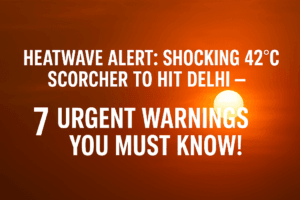Heatwave Alert: Shocking 42°C Scorcher to Hit Delhi – 7 Urgent Warnings You Must Know!
Delhi and several northern Indian states are bracing for an intense heatwave, with temperatures expected to soar up to 42°C by April 10, according to the India Meteorological Department (IMD). A red alert has been issued, warning of extreme heat conditions between April 6 and 7. Unusually, the heatwave season began as early as late February, signaling what could be one of the hottest summers in recent history. Regions including South Haryana, Western UP, Punjab, Gujarat, Rajasthan, and parts of Madhya Pradesh are also on high alert.
The IMD has predicted above-normal temperatures across most of central, eastern, and northwestern India through June. Traditionally, India faces 4 to 7 heatwave days during this time, but 2025 may see many more, with some areas expected to endure 10 or more. This rise in extreme heat is likely to impact public health, agriculture, and infrastructure. Authorities are advising people to stay indoors during peak hours, drink plenty of water, and take extra precautions to stay safe.

Heatwave Alert: Shocking 42°C Scorcher to Hit Delhi – 7 Urgent Warnings You Must Know!
Delhi is preparing for an extreme heatwave as temperatures are predicted to climb rapidly in the next few days, potentially reaching a blistering 42°C by April 10. The India Meteorological Department (IMD) has issued a red alert—the highest-level warning—for Delhi and multiple northern and central states, signaling severe health risks and urging residents to take immediate precautions. The scorching conditions are expected to peak between April 6 and 7, with daytime temperatures soaring 2–4 degrees above normal levels. This intense heat is not limited to Delhi; it will also grip regions like South Haryana, Western Uttar Pradesh, Punjab, Himachal Pradesh, Rajasthan, Gujarat, and West Madhya Pradesh.
What makes this situation especially alarming is the unusually early onset of heatwaves this year. The first signs appeared as early as February 27—a rare occurrence in India, where heatwaves typically begin in late March or April. Meteorologists warn that the summer of 2025 could become one of the most brutal in recent memory, with prolonged periods of extreme heat threatening to disrupt daily life, strain energy supplies, and endanger vulnerable populations.
The IMD had previously forecast above-normal temperatures across central, eastern, and northwestern India from April to June. While the country usually experiences 4–7 heatwave days during this time, this year is expected to break that pattern. Experts predict a sharp increase in both the frequency and duration of heatwaves, with several regions likely to endure extended stretches of dangerous heat. States such as Rajasthan, Gujarat, Madhya Pradesh, Maharashtra, Uttar Pradesh, Bihar, Odisha, Chhattisgarh, Telangana, Andhra Pradesh, and parts of Karnataka and Tamil Nadu are anticipated to face a steep rise in heat-related challenges.
Eastern Uttar Pradesh, Jharkhand, Odisha, and Chhattisgarh are among the worst-hit areas, with forecasts suggesting up to 10–11 days of extreme heat. Such conditions could severely impact public health, particularly for outdoor workers, the elderly, and children. Hospitals may witness a surge in cases of heatstroke, dehydration, and respiratory issues. Agriculture, a lifeline for millions in these regions, is also at serious risk. Crops like wheat and vegetables could suffer from heat stress, leading to reduced yields and rising food prices. Additionally, infrastructure such as roads and power grids may sustain damage, and soaring electricity demand could result in blackouts.
Authorities are urging people to take preventive measures to stay safe. Residents are advised to drink plenty of water, avoid outdoor activities during peak sunlight hours (10 AM to 4 PM), and remain in cool, shaded areas. Wearing lightweight clothing and using hats or umbrellas when outside can help reduce sun exposure. Communities are encouraged to check on neighbors, especially those living alone or without access to cooling facilities. The government has also directed local administrations to set up heat relief shelters, distribute oral rehydration solutions, and ensure uninterrupted power and water supply in high-risk zones.
The early arrival of heatwaves has heightened concerns about climate change accelerating extreme weather patterns. Scientists point to rising global temperatures, deforestation, and urban heat island effects—where cities trap more heat than rural areas—as major contributors. Delhi, for example, has seen a steady increase in summer temperatures over the past decade, with concrete landscapes and shrinking green cover worsening the heat.
For farmers, the forecast brings deep concern. Many are rushing to harvest crops early to minimize losses, while others fear irrigation shortages as water reservoirs dry up. In states like Punjab and Haryana—India’s agricultural heartland—prolonged heat could stunt crop growth, destabilizing both local economies and national food security.
The IMD’s warnings highlight the urgent need for long-term strategies to manage heat risks. Urban planners emphasize the importance of planting more trees, expanding green spaces, and designing buildings with better ventilation. Some cities have started implementing heat action plans that include public awareness campaigns and training healthcare workers to respond to heat-related emergencies.
As temperatures rise, the demand for cooling appliances like air conditioners and fans will surge, putting pressure on India’s power infrastructure. Last year, several states experienced hours-long blackouts during peak summer, and officials are now working to prevent a repeat by upgrading power grids and promoting energy-efficient practices.
In summary, India is heading into a summer of exceptional intensity. The combination of early heatwaves, record-breaking temperatures, and widespread geographic impact calls for collective action—from individual responsibility to policy-level planning. While the immediate priority is staying safe in the coming months, this crisis also underscores a broader need to strengthen climate resilience and invest in sustainable development. For now, staying informed, prepared, and cautious remains the best defense against the rising heat.
You must be logged in to post a comment.